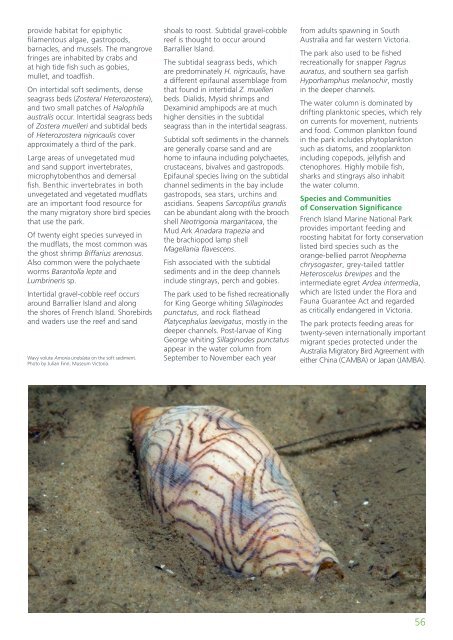Marine Natural Values Study Summary - Parks Victoria
Marine Natural Values Study Summary - Parks Victoria
Marine Natural Values Study Summary - Parks Victoria
Create successful ePaper yourself
Turn your PDF publications into a flip-book with our unique Google optimized e-Paper software.
provide habitat for epiphyticfilamentous algae, gastropods,barnacles, and mussels. The mangrovefringes are inhabited by crabs andat high tide fish such as gobies,mullet, and toadfish.On intertidal soft sediments, denseseagrass beds (Zostera/ Heterozostera),and two small patches of Halophilaaustralis occur. Intertidal seagrass bedsof Zostera muelleri and subtidal bedsof Heterozostera nigricaulis coverapproximately a third of the park.Large areas of unvegetated mudand sand support invertebrates,microphytobenthos and demersalfish. Benthic invertebrates in bothunvegetated and vegetated mudflatsare an important food resource forthe many migratory shore bird speciesthat use the park.Of twenty eight species surveyed inthe mudflats, the most common wasthe ghost shrimp Biffarius arenosus.Also common were the polychaeteworms Barantolla lepte andLumbrineris sp.Intertidal gravel-cobble reef occursaround Barrallier Island and alongthe shores of French Island. Shorebirdsand waders use the reef and sandWavy volute Amoria undulata on the soft sediment.Photo by Julian Finn, Museum <strong>Victoria</strong>.shoals to roost. Subtidal gravel-cobblereef is thought to occur aroundBarrallier Island.The subtidal seagrass beds, whichare predominately H. nigricaulis, havea different epifaunal assemblage fromthat found in intertidal Z. muelleribeds. Dialids, Mysid shrimps andDexaminid amphipods are at muchhigher densities in the subtidalseagrass than in the intertidal seagrass.Subtidal soft sediments in the channelsare generally coarse sand and arehome to infauna including polychaetes,crustaceans, bivalves and gastropods.Epifaunal species living on the subtidalchannel sediments in the bay includegastropods, sea stars, urchins andascidians. Seapens Sarcoptilus grandiscan be abundant along with the broochshell Neotrigonia margaritacea, theMud Ark Anadara trapezia andthe brachiopod lamp shellMagellania flavescens.Fish associated with the subtidalsediments and in the deep channelsinclude stingrays, perch and gobies.The park used to be fished recreationallyfor King George whiting Sillaginodespunctatus, and rock flatheadPlatycephalus laevigatus, mostly in thedeeper channels. Post-larvae of KingGeorge whiting Sillaginodes punctatusappear in the water column fromSeptember to November each yearfrom adults spawning in SouthAustralia and far western <strong>Victoria</strong>.The park also used to be fishedrecreationally for snapper Pagrusauratus, and southern sea garfishHyporhamphus melanochir, mostlyin the deeper channels.The water column is dominated bydrifting planktonic species, which relyon currents for movement, nutrientsand food. Common plankton foundin the park includes phytoplanktonsuch as diatoms, and zooplanktonincluding copepods, jellyfish andctenophores. Highly mobile fish,sharks and stingrays also inhabitthe water column.Species and Communitiesof Conservation SignificanceFrench Island <strong>Marine</strong> National Parkprovides important feeding androosting habitat for forty conservationlisted bird species such as theorange-bellied parrot Neophemachrysogaster, grey-tailed tattlerHeteroscelus brevipes and theintermediate egret Ardea intermedia,which are listed under the Flora andFauna Guarantee Act and regardedas critically endangered in <strong>Victoria</strong>.The park protects feeding areas fortwenty-seven internationally importantmigrant species protected under theAustralia Migratory Bird Agreement witheither China (CAMBA) or Japan (JAMBA).56
















